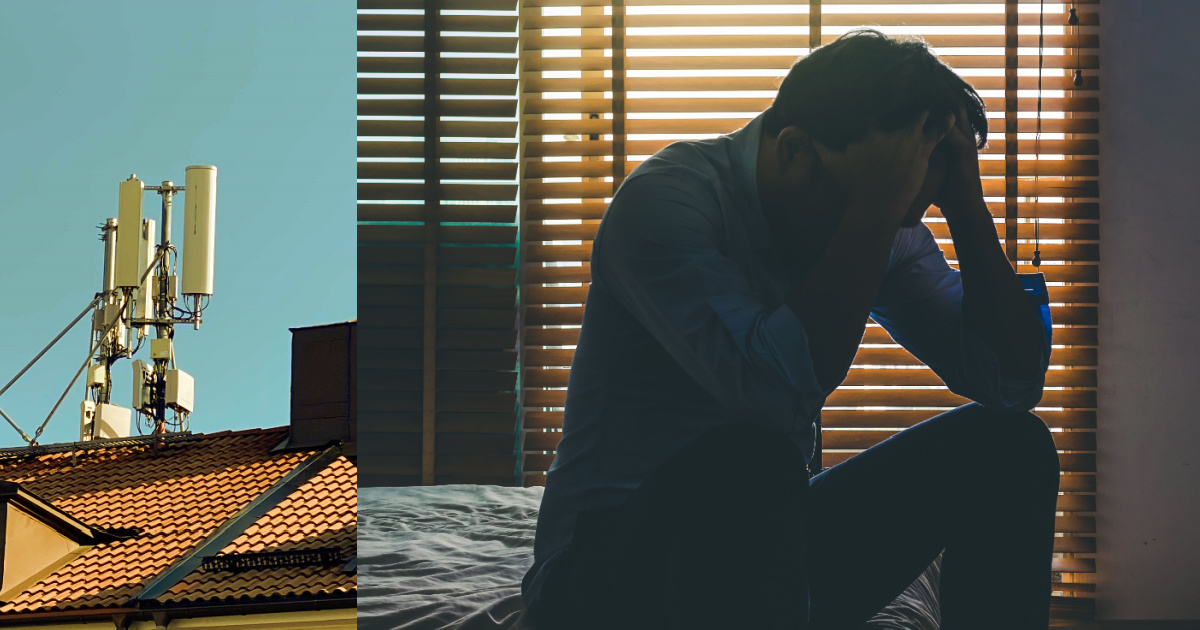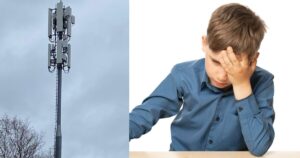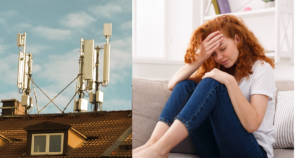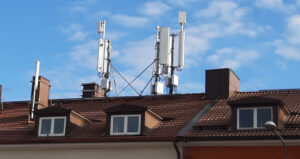A new case study shows that a man in his 40s, who had a 5G base station deployed 20 metres from his home, quickly developed severe ill health symptoms typical of the microwave syndrome. After only one week, the man was no longer able to stay in his home due to the severity of his symptoms. Measurements of microwave radiation in the home show extremely high levels from the 5G antennas, confirming many scientists’ early warnings that 5G would lead to a massive increase in radiation.
The new study was conducted by Mona Nilsson from the Swedish Radiation Protection Foundation and Lennart Hardell from the Swedish Research Foundation for Environment and Cancer. It is the fifth case study they have published since the roll out of 5G began over three years ago. These case studies are so far the only research available on the human health impact of 5G radiation. 5G has been deployed without any study showing that the technology does not harm human health and the environment, which has led to extensive criticism from scientists, medical doctors and NGOs (see for example www.5gappeal.eu).
This new case study, published in the Journal of Community Medicine & Public Health, examines the health consequences 5G had on a man in his 40s, previously in good health, who suddenly had a 5G base station installed just 20 metres from his home. Within a short time, the man suffered various symptoms, the severity of which increased during the week he stayed in the apartment until he moved out.
Typical symptoms of microwave syndrome
The man developed severe headaches, tingling and burning sensations in his body, severe heart problems in the form of a high and irregular pulse and pain in the heart region. Furthermore, his short-term memory was severely impaired, he was abnormally tired, had sleep problems and developed a tendency to depression. All these symptoms have been well described for a long time as an effect of prolonged exposure to microwave radiation similar to that emitted by mobile phone base stations. Several decades ago, they were referred to as microwave syndrome or microwave illness. The man’s body parts also swelled, making it difficult for him to use his shoes.
After the man moved to another residence with much lower radiation levels and without 5G radiation, the man regained his health and his symptoms gradually disappeared. However, each time the man visited his home near the 5G base station, the symptoms returned relatively quickly and took longer to subside after each visit.
Measurements of radiation in the home were carried out twice. The first time, the radiation was measured with Safe and Sound Pro II, which showed that the radiation in several rooms in the home reached maximum levels for the meter, i.e. over 3,180,000 μW/m2, measured as a peak value. These levels are the highest measured so far in the case studies on the health impact of 5G. A follow-up measurement used a Narda meter that measures root mean square or RMS values. These RMS measurements showed maximum values of 997,274 μW/m2 in the living room and 1,368,021 μW/m2 in one of the bedrooms.
Measured levels in relation to known risks
The measured levels are extremely high compared to the levels known to cause ill health from previous generations of mobile phones.
Repeated studies have shown that already from levels above 100-500 μW/m2 the risk of developing similar symptoms increases with chronic exposure to GSM or 3G radiation. These studies forms the basis for several organizations to recommend that people should not be exposed to levels of radiation in the home that exceed between 1-100 μW/m2 depending on location (bedroom or not), sensitivity or technology used.
For example, the Parliamentary Assembly of the Council of Europe recommended in an adopted resolution in 2011 that exposure should not exceed 100 μW/m2 . The Salzburg Health Department has recommended a maximum of 1 μW/m2.
Measured levels in relation to limits recommended by ICNIRP
The table below shows the average values (during 2 minutes) measured with the Narda meter, which are relatively comparable to the ICNIRP 2020 limits (10,000,000 μW/m2 in average value during 30 minutes) which are also recommended by the WHO and the EU Commission. The table shows that the levels causing the man’s rapid health deterioration and severe symptoms are significantly lower than the ICNIRP limits. The chairman of ICNIRP, Eric van Rongen, has claimed this extremely high limit will protect everyone against any harmful effects from 5G exposure:
“The most important thing for people to remember is that 5G technologies will not be able to cause harm when these new guidelines are adhered to.”
At the same time, the measured values in the home are extremely much higher than those recommended by European medical doctors and scientists in the EuropaEM EMF guidelines 2016. The measured average values in the man’s apartment exceed permitted values in countries such as Switzerland and Russia, which have 100 times lower limits than ICNIRP’s, i.e. around 100,000 μW/m2.
Table: Measured levels RMS in μW/m2 (Narda meter) in the apartment compared to levels recommended by ICNIRP, WHO, EU and EuropaEM EMF guidelines 2016.
| Place | Narda RMS max | Narda RMS average |
ICNIRP
WHO EU average |
EuropaEM
2016 max |
| Living room | 997 274 | 135 983 | 10 000 000 | 1-100 |
| Living room | 571 624 | 101 306 | 10 000 000 | 1-100 |
| Bedroom | 1 368 021 | 332 732 | 10 000 000 | 1-100 |
| Entrance | 1 043 047 | 303 687 | 10 000 000 | 1-100 |
The ICNIRP limits thus allow for an extremely high exposure of pulse-modulated microwave exposure compared to levels reommended by EuropaEM EMF Guidelines 2016 or the levels that caused rapid deteriorated health in this case study. The ICNIRP2020 limits are 10,000,000 m2 measured as a mean value over 30 minutes for the 5G frequency used (3.5 GHz). There are no studies showing that long-term whole-body exposure to GSM, 3G, 4G or 5G at such extremely high levels does not harm human health. Thus, there is no scientific basis for claiming that ICNIRP limits would protect people from adverse health effects from real life full body chronic mobile phone base station radiation. There is also no scientific evidence that levels 100-10,000 times lower (averaged over 30 minutes) do not cause adverse health effects from chronic whole-body exposure. Yet the telecoms companies, the ICNIRP members, the WHO and the EU Commission claim that these limits would protect against adverse health effects from long-term exposure to 5G radiation.
The ICNIRP limit protects only against immediate harmful effects due to heating. It does not protect against all adverse health effects that are not due to acute heating, i.e. when the radiation is so intense that it heats up the body within one hour. This means that the ICNIRP limit does not protect against the symptoms of microwave syndrome, such as headaches, difficulty sleeping, cardiac effects, abnormal fatigue, etc. It lacks protection against cancer, neurological diseases and other chronic diseases resulting from prolonged exposure at levels lower than those that do not cause immediate heating.
In a scientific paper published in 2022, world-leading experts in the field concluded that the ICNIRP limits are based on a number of incorrect assumptions. The authors called for the public to be informed of the risks, the ICNIRP limits to be lowered, further deployment of 5G to be stopped, as well as for new limits that also protect wildlife from harmful effects. The ICNIRP limits offer no protection against harmful effects on wildlife.
Promotional brochure for ICNIRP limits
The heavily criticized organization ICNIRP that is the origin of these extreme limits has known links to the telecom industry. The ICNIRP limits are also of great economic importance to the telecom industry because, according to Ericsson, it will be “difficult or impossible” to roll out 5G if the limits from ICNIRP were to be slightly lower (100 times lower as in Switzerland and Russia, for example). For this reason, telecom companies have lobbied for countries with better protection and lower limits to raise them to the ICNIRP levels. And they have recently convinced Italy to raise the limits (from circa 100 000 to 600 000 μW/m2). Another indication of the importance of the ICNIRP limits for telecom companies is that the GSM Association, an interest organization representing the world’s largest telecom operators and led by Swede Mats Granryd (former president of Tele2 and before that 15 years employment within Ericsson), has published a promotional brochure pushing for the ICNIRP 2020 limits. Two Members of the European Parliament commissioned an investigation into ICNIRP’s links to the telecoms companies in a report published in 2020.
It is very clear that the ICNIRP limits are primarily tailored to the needs of telecoms companies and that they do not protect against many of the health risks that have become increasingly evident in recent years (see www.emfscientist.org).
Conclusion
This study shows that 5G caused very high exposure to pulse-modulated microwaves and severe ill health within a week. The study confirms previous case studys on 5G health effects and scientist’s early warnings about serious potential health consequences from 5G. Further the study show that levels of radiation well below the ICNIRP limits are dangerous to human health.
Sources:
Nilsson M, Hardell L (2023) A 49-Year-Old Man Developed Severe Microwave Syndrome after Activation of 5G Base
Station 20 Meters from his Apartment. J Community Med Public Health (pdf)
Hardell, Nilsson. Mikrovågsstrålning på hustak gav medicinska symptom som överensstämmer med mikrovågssyndromet. Medicinsk Access 1/2022. Pdf
Hardell, Nilsson. Case Report: The Microwave Syndrome after Installation of 5G Emphasizes the Need for Protection from Radiofrequency Radiation. Ann Case Report. 8: 1112. DOI: 10.29011/2574-7754.101112. pdf
Nilsson, Hardell. Development of the Microwave Syndrome in Two Men Shortly after Installation of 5G on the Roof above their Office. Ann Clin Case Rep. 2023; 8: 2378. pdf
Hardell L, Nilsson M, Case Report: A 52-Year Healthy Woman Developed Severe Microwave Syndrome Shortly After Installation of a 5G Base Station Close to Her Apartment. Ann Clin Med Case Rep. 2023; V10(16): 1-10. pdf
Nilsson, Hardell. 5G Radiofrequency Radiation Caused the Microwave Syndrome in a Family Living Close to the Base Stations. Journal of Cancer Science and Clinical Therapeutics. 7 (2023): 127-134 Open access
Hardell, Nilsson, Koppel, Carlberg. Aspects on the International Commission on Non-Ionizing Radiation Protection (ICNIRP) 2020 Guidelines on Radiofrequency Radiation; Journal of Cancer Science and Clinical Therapeutics 5 (2021): 250-285. pdf
More reading:
Experts Raise Public Health Fears About Microwave Syndrome From 5G Masts, The Daily Sceptic
5G Towers Can Make Healthy People Sick, Two Case Reports Show, The Defender
U.S. Invests $1.5 Billion to Spur 5G Rollout Despite New Evidence of ‘Devastating’ Health Issuesm The Defender







